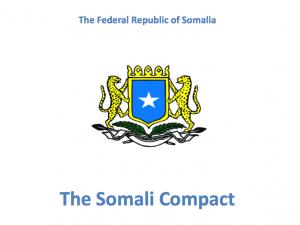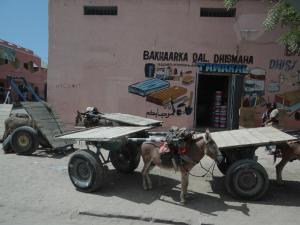Eighteen self-declared ‘Fragile States’ have endorsed the New Deal, and its process is already being implemented in Timor Leste, South Sudan, Sierra Leone, and Liberia. On September 16th, at a conference in Brussels, the Somali Federal Government and international community endorsed the Somali New Deal Compact, with pledges of € 1.8 billion. EuropeAid’s Timothy Baines was instrumental in getting the Compact in place, and shares his insights.
In the past year and a half, Somalia has installed an internationally recognised government and has made progress on the security front. Now it has adopted the New Deal programme, in the form of the Somalia Compact – consisting of three main chapters:

The first sets out the situation in Somalia, describes the process of getting to the Compact, and looks at its implications. The second identifies the top-most priorities for the next three years through five Peace and Statebuilding Goals (PSGs); Inclusive Politics, Security, Justice, Economic foundations, and Revenues & Services. The top three priorities, with annual milestones, of what needs to be achieved for each of these PSG’s are described, having been identified through a process of special working groups comprised of Somalis - from parliament, government and civil society, and international stakeholders. Finally, the Compact sets-out commitments to aid effectiveness principles.
Getting to this Compact required a huge effort on behalf of all stakeholders, with the European Union taking on the role of lead donor. Timothy Baines was seconded from EuropeAid’s Fragility & Crisis Management Unit to provide Headquarter support to the whole EU team. He spent over thirteen weeks in Somalia and Kenya, working as one of the international Technical Advisors (others coming from the UN and World Bank/OECD), consulting with the Somali government, parliament, civil society, and regions in Somalia, and providing information and advice to the EU Ambassador and Member States.
In his office in Brussels last month, he provided insight to the New Deal process, and his thoughts on its future.
C4D: Please tell us about the background to the New Deal for Somalia
Tim Baines: I think it’s fair to say that, increasingly, people have become aware that there is a duality between security and development - without security it is very difficult to do development and without development it’s more difficult to reach a secure and stable situation. So the two go hand- in- hand, and if you look at Somalia over the past 20 years it has been an example, unfortunately, of insecurity and instability.
The window of opportunity that allowed the New Deal process to move forward was the sense that the Somali government needed all the support it could get and that there was a small, but noticeable increase in the security situation. A bit more stability was starting to take place mainly through the amazing work being done by the African Union Peace Keeping Force, AMISON, but also through the increased involvement of the Somali National Army and police forces, which the EU is supporting. With a new government coming in place and this seemingly positive trend on the security side, the New Deal and the Compact were an opportune element to bring to the table.

If you look at the EU’s intervention in Somalia, we of course are already very involved: through life-saving humanitarian interventions and development cooperation actions, but we also have three Common Security and Defence Policy (CSDP) missions on-going – off the coast of Somalia, which supports the World Food Programme shipments of food into Somalia and aims at restricting piracy; we have a mission which was in Uganda but is now in Somalia training the Somali armed forces; and the third mission is more of a regional mission which is aimed at the training and capacity building of the coastal forces in Djibouti, Somalia, Kenya and Tanzania.
All of these things are leading towards Somalia becoming a more stable and more secure country – but we have a long way to go.
By focusing our attention on the top key priorities for the 2014-2016 period, we hope that the situation will improve and that Somalia itself will be able to assume responsibility for its own internal security and that AMISOM starts to play a smaller role. And, at the end of the day, we won’t need African peacekeepers anymore.
Momentum is very important. Once you starting losing this momentum, it is easy to see the whole process fizzling out, so having (continued) high-level and all-encompassing support is critical.
How will the Compact affect aid delivery?
An important chapter of the Compact is captured in the Aid Effectiveness Principles part, which is where we spell out what the development partners will do – how are we going to use country systems, how are we going to channel our development cooperation. The primary aim is to diminish duplication, increase coordination and increase government oversight and ownership.

This has direct implications on how EuropeAid works in Somalia, because what we are seeing now a is a plethora of interventions from the EU side, the Member State sides and others going into Somalia, making it virtually impossible to track what is happening.
Part of the Compact means trying to bring it all together in a more structured way so that we can actually see who is doing what, so that the Somali government gets more ownership and starts being able to deliver itself on the ground to its people.
Our 11th European Development Funds (EDF) programme will be fully in line with the Compacts priorities – that’s the first step.
The second step is that we have to look at what are we doing with the non-EDF flows into the country to make sure that whenever we are doing as intervention, it doesn’t contradict what is in the Compact.
A key element of the Compact is also that we want to diminish the number of flows of development into the system and one of the things that we are strongly working on, with the World Bank and UN, is the putting together of multi-partner Funds, which will be ‘housed’ in the Somali Development and Reconstruction Facility.
How flexible and inclusive is the New Deal?
Right from the beginning, we made it clear to everyone that the resulting product would be a living document, that it would change with the situation and evolve, and we would have to revisit the content over time.

Part of the philosophy is exactly that: you are talking to a fragile country and the government, but also the people behind that government - civil society has to play a big role, as does parliament, because at the end of the day they also represent the people.
One of the big challenges in the early stages of the process was to convince the government to bring on board civil society and parliament in all of the working groups.
We also initiated a Fragility Assessment; this is also part of the discourse of the New Deal. It involves the country carrying out a self-assessment of where they are in terms of fragility, looking at the five PSG’s and asking themselves what could be ways to improve the situation. The findings helped in defining the Compact’s priorities and in getting the voices heard from several parts of the country.
The workshops that feed the Fragility Assessment continue. In the next few months there will be more asking of the same questions. We see a clear role for civil society participating in these Fragility Assessments and playing the role of watchdog to the commitments made in the Compact.
What are the next steps?
The conference in September had a pledging component to it of € 1.8 billion. One of the exercises taking place now is revisiting those pledges, contacting those countries and asking in what PSGs do you have an interest. We need to make sure that whatever new money comes on board is channelled through the multi-donor Trust Funds as much as possible.
One of the issues that needs to happen within the EU family is a reflection of what the Compact means for the three afore-mentioned CSDP missions. What does it mean for the political outreach we are doing? How do the Member States and EU Delegation to Somalia deal with the political implications of the Compact? In the next few weeks we will have internal DEVCO discussions to take this forward and then, in a second stage, we will need to have a discussion with the wider EU family - what will the EEAS do with the Compact, what will CSDP structures do about it, and how can we bring it all together so that we have a true comprehensive approach of the EU towards Somalia.
The Compact, as it has been written, has a period of three years (2014 to 2016), and the priorities and milestones have been identified and put in place to make them as realistically achievable as possible. The international community now has the challenge to translate our commitments into reality and to put in place programmes and interventions in line with the Compact priorities.
What we want to see at the end of 2016 is a more stable, secure and resilient Somalia – measured by an improved situation across the five PSGs. We will probably not hit all the targets we have set ourselves but we will have put a serious dent in the challenges.
Reality is reality, however. A few weeks after a hugely optimistic international conference, we had the attacks in Kenya by Al Shabaab with a clear reminder that security is still very weak on the ground. It will take hard work.
Watch the full-length interview with Timothy Baines in the Public Group on Fragility
This collaborative piece was drafted with input from Timothy Baines, with support from the capacity4dev.eu Coordination Team.

Log in with your EU Login account to post or comment on the platform.